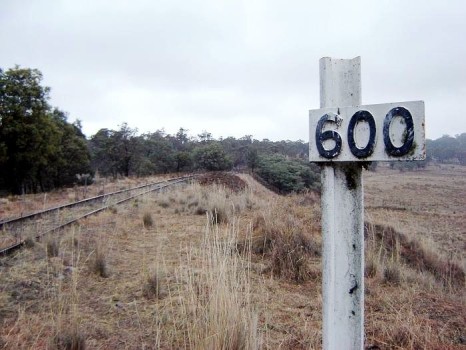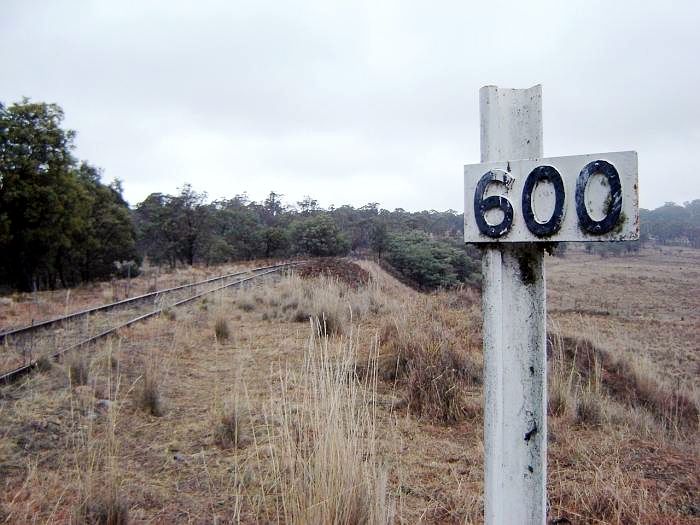
The railway north of Armidale have been disused for over 25 years.
There is an initiative to convert the track from Black Mountain to Ben Lomond to a rail trail for recreation walking and riding for both horse and cycle.
Another initiative is to run a heritage train from Armidale north and there has been whispers of other transport proposals but nothing definite at this time.
Here in the New England, many memories are still fresh about the closure of the rail line as far south as Tamworth. Whilst that was short-lived and passenger services were reinstated to Armidale, the Northern Railway exists a mere shadow of its former self.
SLA will provide a forum about the future of the Northern Railway on Thursday 7th May, 7pm at Kent House, opposite Central Park. Gold coin donation appreciated.

Many in the new england wish that the tracks stay. Ripping them up or cementing them in is a serous thing and counsils are so sure that there never will be another train on those tracks. Now what is wrong with the trail being beside the tracks? I hope this rail trail doesnt go ahead.
A Rail Trail will bring a much needed tourism boost to the New England Region, and help to increase patronage on the rail link to Armidale. The old tracks north of Armidale are beyond safe usage condition and there is no purpose served by leaving them in place. If a railway becomes viable in the future the trail could easily be converted back. In the meantime the community could benefit from reuse of the existing path. The many narrow cuttings and raised sections make a trail alongside the rails impossible
Unfortunately David Mills has cancelled his presentation due to unforeseen circumstances. The forum will go ahead but (at this time of writing this) with no presentations from any interested groups outside of SLA 🙁
It is evident that a rail trail would provide the Northern Tablelands’ with multiple benefits which include a boost for small businesses, an investment in community health and a way to bring more awareness of the unique history of the rail corridor.
The NSW Govt has a called for rail trail proposals. It is not offering funds for trails-with-rails or tourist trains. Nor is it offering the $hundreds of millions it would take to bring the old superceded railway line back to service. It is beyond reviving.
From the perspective of sustainability, a rail trail is the most viable option for the long abandoned rail corridor. Public transport has shifted to buses. Train services will not be returning in the foreseeable future. All indications are that a rail trail is the smartest, most sustainable use of the rail corridor.
The northern rivers rail trail group have been working hard at getting the old railway tracks from Murwillumbah to Casino developed for a number of years now.
Check them out at http://www.northernriversrailtrail.org.au/trail/overview/
It would be great to have a rail trail in the New England area.
When I lived in Ontario, Canada, several of the abandoned rail lines had been converted to rail trails. They are a wonderful recreational resource both in the summer for walkers, cyclists and equestrians and in the winter (not an option for us of course) for cross-country skiers. The rail trails pass through some splendid scenery, not normally accessible to most of us, and offer a satisfying few hours or day out for all who use them. Sustainable recreation and tourism at its best.
Public transport has shifted to buses, as Graham points out, and at this time not only will train services not be returning but existing services may be in danger. But is this a path for long term sustainability? Indications are coal freight will take up more time on the tracks pushing passengers into buses. Is the use of the rail corridor for locals or mainly non-locals who perhaps will fly in-fly out? They may have to do this if they can’t catch the train. Perhaps the Rail supporters and Rail trail supporters should join froces to ensure the continuation of the passenger service to Armidale and get a decent bicycle transport system by train in place.
Why not fill in to the top of tracks with fine road-metal so it’s walkable, but easy to remove if the rails are ever recommissioned?
I am pleased to confirm that the New England Railway Inc will be presenting at the meeting.
Great Continental Railway Journeys (Copenhagen to Oslo) on SBS tonight just showed some great little pedal-driven railway carts used by tourists to travel along a section of disused railway line (for sightseeing/ picnics etc)
They looked like pretty simple constructions of wood and steel, which run along the tracks. Apparently they were originally used by the railway workers to check the line.
What a great idea and perfect for the Northern Rail Line!
I’m sure anyone interested can probably access the program on the SBS on demand website.
The Great Northern Railway Line (GNRL) has strategic military significance for the defence of Australia moving heavy weaponry and troops from south to north across the country. First prove that the Walking Trail model works on the Guyra to Dorrigo line that is formed and unused since work ceased in the Great Depression and then think about how to renovate and upgrade the GNRL to carry the increased rail freight between capital cities that is growing at 7% per year. Get freight on the rails where one train creates as much pollution as 40 heavy freight vehicles carrying the same mass of load. This would also make the roads safer for family car drivers.
Declared interest – we lease the old railway freight yards in Armidale , and have done for 20 years . The infrastructure was built in 1884 , and the design is from last century as well . I am actually in favour of rail freight but there is no possible way that this infrastructure could be adapted to modern container or bulk freight for example.The precinct is heritage listed as it should be .
Issue 1 : The essential problem with governments and re-opening rail corridors for freight is that the fuel excise on road diesel fuel ( state and federal) amounts to around 50c per litre or more . – why would any government seriously promote rail freight over road freight and destroy its own cash flow . They will only ever pay lip service to rail freight , especially in marginal freight corridors like ours .
Issue 2 : Rail corridors for tourism is a great idea . It need not be expensive , but needs a proper cost benefit analysis . Rail lines need not be ripped up . As Chris suggested , simply fill the track with compacted gravel , easily removable . Light vehicle , horse riding , walking , all possible , but a proper analysis needs to be done .